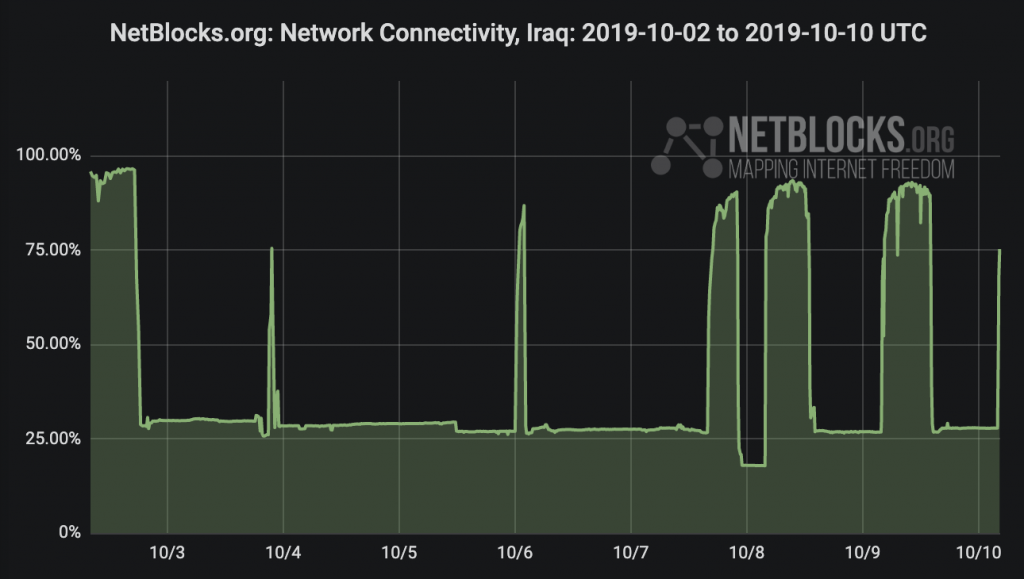Network data from the NetBlocks internet observatory confirm that Iraq has introduced a nighttime internet curfew, consistent with reports from IT industry workers in recent days.
Confirmed: #Iraq has partly restored internet access at 7:00 a.m. Baghdad time for the 3rd consecutive morning, making it the first documented country to introduce a nightly internet curfew at nation-scale.
⏰Curfew times: 5:00 p.m. 7:00 a.m.
? https://t.co/tMKR6oDGQA pic.twitter.com/vJnWyDskj2
— NetBlocks (@netblocks) October 10, 2019
Measurement data show that internet access has been systematically cut for the second consecutive night between the hours of 5:00 p.m. and 7:00 a.m. Baghdad time (14:00 UTC and 4:00 UTC). The return is the third consecutive restoration of access to take place at 7:00 a.m.
Iraq enters internet history as the first recorded country to implement a systematic nighttime curfew at nation-scale by cutting and restoring internet access at the same times for two consecutive nights.
However, the practice has been previously observed at smaller scale. In 2016, digital advocacy group Bahrain Watch documented the first recorded internet curfew between 7:00 p.m. and 1:00 a.m. each night in the village of Duraz where there had been ongoing protests.
The dubious record for first documented nightly internet curfew at subnational scale goes to the restive village of Duraz in Bahrain, which in 2016 cut access between 7:00 p.m. and 1:00 a.m. each night for more than 100 days, as documented by @BHWatch ?https://t.co/l01T4mQNWZ
— NetBlocks (@netblocks) October 10, 2019
It is believed that Iraq has introduced formal curfew times after push-back from industry, which has incurred costs spiralling into the hundreds of millions as a direct result of the internet disruptions, estimated using figures from the COST tool.
While internet access has partly returned to affected parts of Iraq, mobile internet access and social media platforms remain disrupted in most places even when access is restored.
Meanwhile, autonomous regions in the north remain unaffected by Iraq’s internet shutdown introduced in response to ongoing protests.
Update: Like clockwork, internet access has been cut again across most of #Iraq as of 5:00 p.m. Baghdad time (2:00 p.m. UTC) as part of a government order that bans communication outside of office hours ⏱? #IraqProtests
— NetBlocks (@netblocks) October 10, 2019
? https://t.co/tMKR6oDGQA pic.twitter.com/Ckjmzn3G8S
Update: #Iraq has partly restored internet access as of 7 a.m. Baghdad time in compliance with an internet curfew imposed between the hours of 5 p.m. and 7 a.m. each night.
Social media and messaging apps remain restricted, as do most mobile networks.
? https://t.co/tMKR6oDGQA pic.twitter.com/fInAFmg4zh
— NetBlocks (@netblocks) October 11, 2019
Read more: Iraq blocks Facebook, Twitter, WhatsApp and Instagram, then shuts down internet amid civil unrest
Methodology
Internet performance and service reachability are determined via NetBlocks web probe privacy-preserving analytics. Each measurement consists of latency round trip time, outage type and autonomous system number aggregated in real-time to assess service availability and latency in a given country. Network providers and locations are enumerated as vantage point pairs. The root cause of a service outage may be additionally corroborated by means of traffic analysis and manual testing as detailed in the report.
NetBlocks diffscans, which map the IP address space of a country in real time, show internet connectivity levels and corresponding outages. Purposeful internet outages may have a distinct network pattern used by NetBlocks to determine and attribute the root cause of an outage, a process known as attribution which follows detection and classification stages.
NetBlocks' methodology sets standards for the diagnosis and classification of internet curfews and curfew-style network incidents. A series of disruptions qualifies as a curfew in either of two conditions:
- After internet access has been cut and restored at the same or similar times for two consecutive nights without public disclosure of the practice
- Immediately upon the implementation of a government-issued network curfew order.
A curfew-style pattern is a series of incidents that meets the first criterion in the absence of technical or geopolitical implication of intent.
NetBlocks is an internet monitor working at the intersection of digital rights, cyber-security and internet governance. Independent and non-partisan, NetBlocks strives to deliver a fair and inclusive digital future for all.
[ press | contact ] Graphics and visualizations are provided for fair use in unaltered form reflecting the meaning and intent in which they were published, with clear credit and source attribution to NetBlocks. Intellectual property rights are protected including but not limited to key findings, facts and figures, trademarks, copyrights, and original reporting, are held by NetBlocks. Citation and source attribution are required at the point of use.

